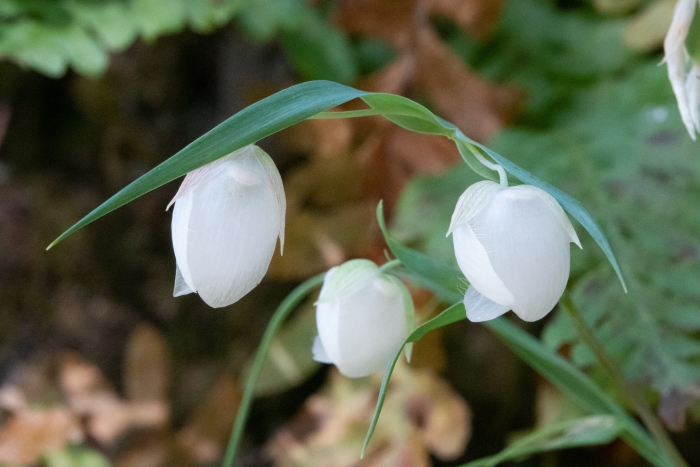White Fairy-Lantern
(Calochortus albus)
White Fairy-Lantern (Calochortus albus)
/
/

Kyle Nessen
Public Domain
Image By:
Kyle Nessen
Recorded By:
Copyright:
Public Domain
Copyright Notice:
Photo by: Kyle Nessen | License Type: Public Domain | License URL: http://creativecommons.org/publicdomain/zero/1.0/ | Rights Holder: Kyle Nessen | Publisher: iNaturalist | Date Created: 2019-05-12T15:39:40-07:00 |


























































Estimated Native Range
Summary
Calochortus albus, commonly known as White Fairy-Lantern, is a deciduous perennial herb native to the oak woodlands and mixed evergreen forests of California, particularly in the Coast Ranges and the Sierra Nevada foothills. This species thrives in the dappled sunlight of its native habitat and is adapted to the Mediterranean climate with wet winters and dry summers. The plant reaches a height of 20–80 cm with erect to arching, slender, glaucous stems that are simple to branching, measuring 7.5-80 cm. The White Fairy-Lantern blooms from late winter to spring, showcasing its nodding, lantern-shaped white flowers that are grouped in 1-2-many clusters. The lanceolate bracts are generally paired and measure 1–5 cm in length. The flowers are particularly showy, making it a desirable species for ornamental use.
In cultivation, White Fairy-Lantern is appreciated for its unique and delicate flowers, which add a touch of elegance to woodland gardens and shaded borders. It is often used in naturalistic plantings and rock gardens. This species requires well-drained soil and can tolerate drought to a moderate extent. During its dormant period, it is essential to reduce watering, allowing the bulbs to dry out as they would naturally experience little or no rain in the wild. It is hardy to -18 °C, and possibly as low as -23 °C, suitable for USDA zones 9-10. Gardeners should provide part shade or full sun, with low or medium amounts of water, and ensure fast-draining soil conditions to mimic its natural environment. Potential problems include bulb rot due to poor drainage or premature autumn growth.CC BY-SA 4.0
In cultivation, White Fairy-Lantern is appreciated for its unique and delicate flowers, which add a touch of elegance to woodland gardens and shaded borders. It is often used in naturalistic plantings and rock gardens. This species requires well-drained soil and can tolerate drought to a moderate extent. During its dormant period, it is essential to reduce watering, allowing the bulbs to dry out as they would naturally experience little or no rain in the wild. It is hardy to -18 °C, and possibly as low as -23 °C, suitable for USDA zones 9-10. Gardeners should provide part shade or full sun, with low or medium amounts of water, and ensure fast-draining soil conditions to mimic its natural environment. Potential problems include bulb rot due to poor drainage or premature autumn growth.CC BY-SA 4.0
Plant Description
- Plant Type: Herb
- Height: 0.3-0.5 feet
- Width: 1-2 feet
- Growth Rate: Moderate
- Flower Color: White, Green
- Flowering Season: Spring
- Leaf Retention: Deciduous
Growth Requirements
- Sun: Part Shade, Full Shade
- Water: Low, Medium
- Drainage: Fast
Common Uses
Border Plant, Low Maintenance, Potted Plant, Rock Garden
Natural Habitat
Oak woodlands and mixed evergreen forests of California
Other Names
Common Names: Pink Fairy Lantern, Lantern Of The Fairies, Globe Lily, White Globe Lily, White Globe-Tulip, Alabaster Tulip, Indian Bells, Satin Bells, Snowy Lily-Bell, Snow Drops
Scientific Names: , Calochortus albus, Calochortus albus var. rubellus, Calochortus albus var. paniculatus, Calochortus lanternus, Cyclobothra alba, Calochortus englerianus, Cyclobothra paniculata,
GBIF Accepted Name: Calochortus albus (Benth.) Douglas ex Benth.